Arlpwe Artists Exhibition Walk Through
David Wroth shares some of the highlights from the Arlpwe Artists 2022 exhibition at Japingka Gallery. Along the way he answers some questions about the artists and art making in this art community.
It's very exciting to have the first ever survey exhibition of works from Ali Curung in Central Australia from the Northern Territory. The community is developing some incredible paintings. They are a community that are known traditionally for artefacts rather than artworks. To receive this body of work has been a thrill for the Gallery. Of the key artists in the exhibition, two of the stars are women artists in their mid seventies. To balance the show up, there's two very exciting artists in their mid thirties. This gives us an idea that the community has a really strong tradition happening.
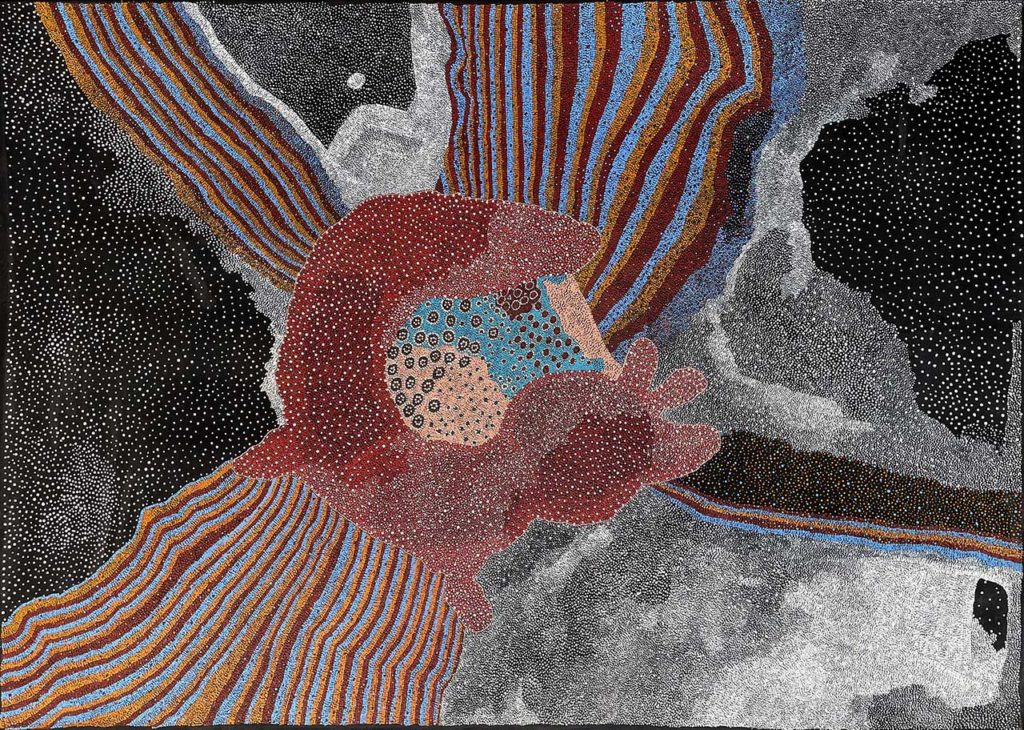
We have a series of works from Judy Nampijinpa Long that are beautifully executed with very fine dot work. This technique becomes something that's much rarer for artists in their seventies. It's quite extraordinary to see this level of artwork and the level of execution, the beautiful dot work that goes into this painting. I would rate Judy Long as the elder painter and the most extraordinary painter in this group with works like this. She has given this work the title of Gecko, but all the paintings in the exhibition relate to journeys on country. They will relate to either totemic journeys by ancestor figures, or they'll relate to processes where people are harvesting food from the country, which we will come to in some of Judy's other paintings.
What is extraordinary about Judy's work is that it sets a standard for very fine dot work that people will be familiar with from the Utopia region. It is a rare commodity in the modern Indigenous art market where there are relatively few really good exponents of this kind of painting. So to suddenly have work by this artist appear in the gallery is a revelation and it is a wonderful selection of works from Judy Nampijinpa.
Q&A
Q. You've said the elders have less fine dot work. Why is that?
A. It tends to become an issue of eyesight. Often young artists in their twenties and thirties will start off doing fine dot work. As artists get further on in their careers, they tend to move away from that kind of registration on the canvas and develop more loose and freewheeling styles of painting. That's why we're saying this is so extraordinary. Artists in their mid seventies will often have eyesight which doesn't allow them to paint in this very finely detailed way. Remembering too, that Aboriginal people often paint sitting on the ground with canvas by their side. They will sit at the edge of the canvas painting. In terms of just the physical demands of making those sorts of paintings and the conditions in which they're made, it is quite difficult. That's another reason why I find these works so remarkable.
This painting is also by Judy and it is called Pureltia. Interestingly, it's a story about gathering a sugary sap from a variety of native tree. The painting is about people traversing country and meticulously searching out these bush foods.
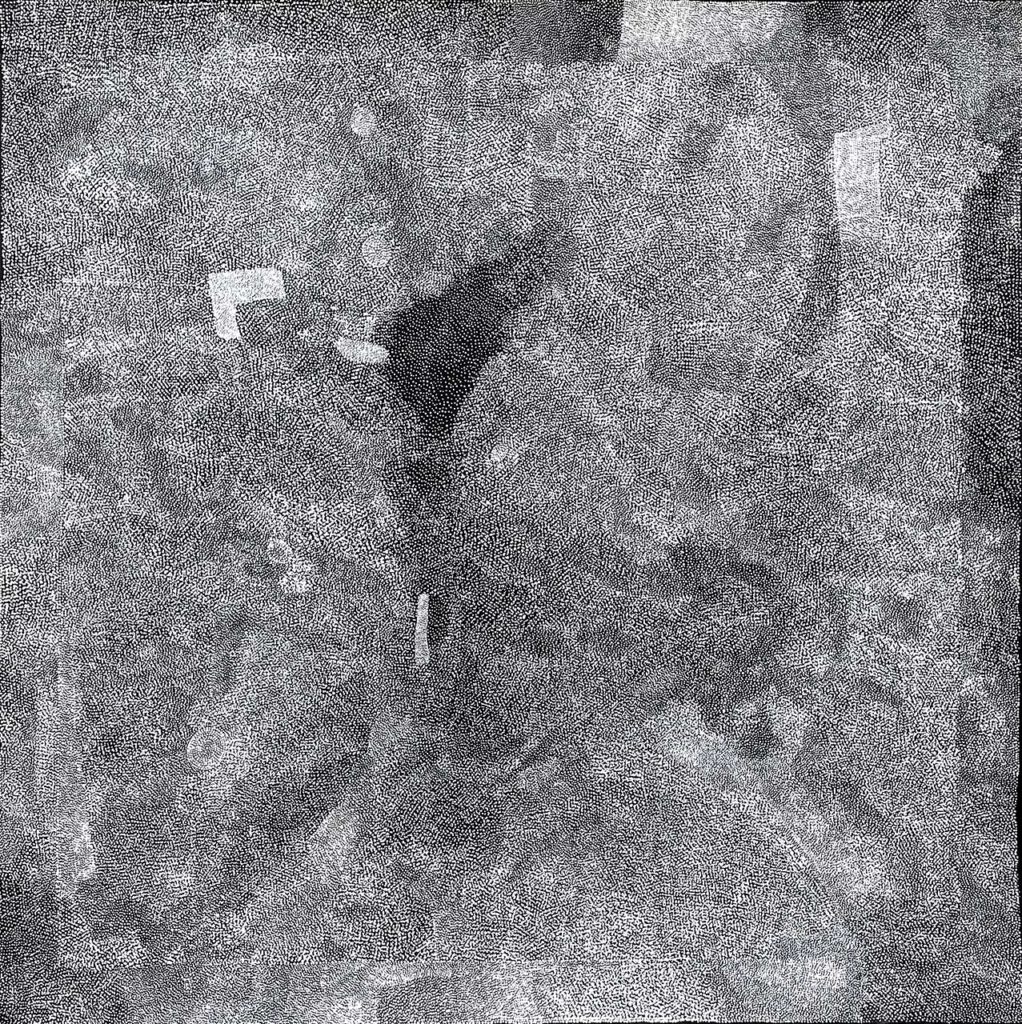
Sonya Napaljarri Murphy is of the younger generation represented in the exhibition. She has three paintings in the show. This painting is about the sandhill country around Ali Curung. Sonya is in her mid thirties, and I think her contribution is really mature in terms of the design of the paintings. They're very hypnotic, arranged with parallel lines that have a subtle blend of earthy colour flowing through a central area, which otherwise is painted using white paint. You've got tones of the earth colours going right across the canvas. The three paintings from Sonya represent a generational change, and I think a wonderful contribution to this exhibition.
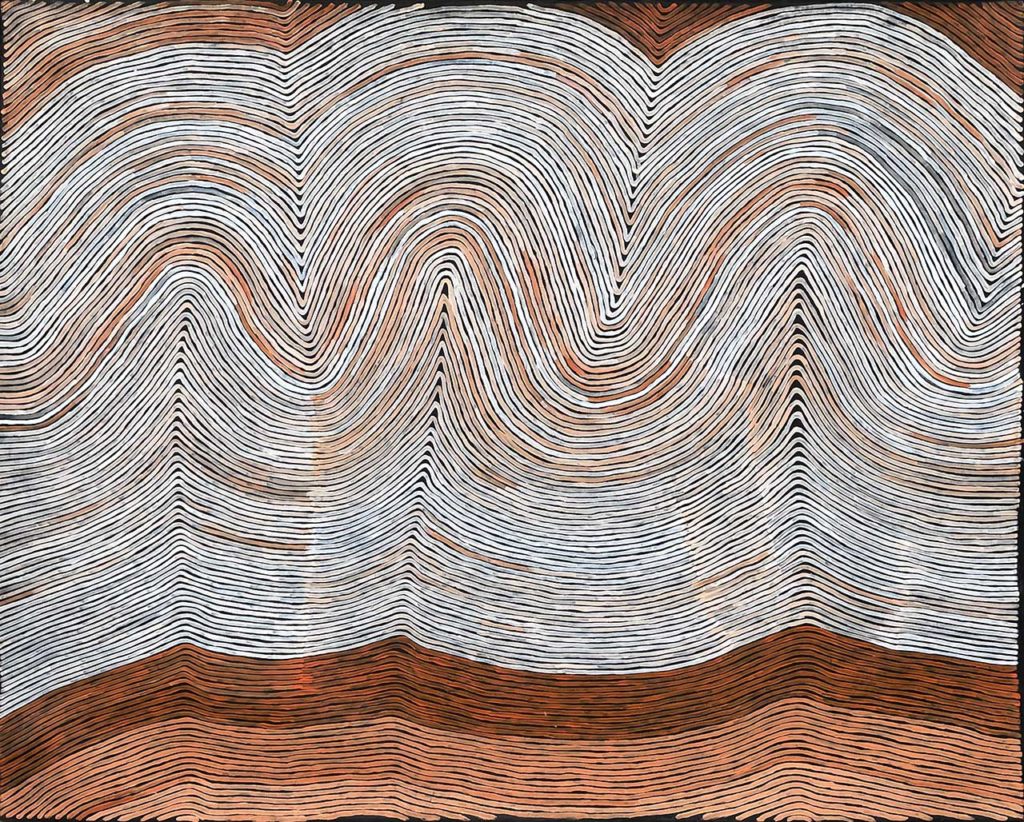
I spoke earlier of having two senior artists in this exhibition. Here we are looking at a painting by the other senior artist, Sarah Nabangardi Holmes. She's called this work Floodways and her contribution to the show has been a series of works that are mostly perceived as black and white. They have parallel lines that make up images of landscape. In this case it is talking about the way that water flows and gathers into pools in the flat sandhill country around Ali Curung.
Sarah is an artist in her mid seventies, she's a very innovative painter, often using freely wandering line work. The entire painting is composed of the linear structures that form into sand hills and gullies and floodways, making up a complete landscape.
As a set of works, I find these works quite mesmerising. She has used a very restrained colour palette with usually just two or three colours and the lines have a very irregular quality. They move and meander as they spread out across the canvas. It's like it hasn't been conceived as a perfect picture, but put together as she's created the work. This is a really strong group of paintings from Sarah Nabangardi Holmes.
Q&A
A. Earlier you made reference to the Utopia style and that this area used to be well know for artefacts before. Can you explain why there are certain styles in one area and a set of diverse style coming from another?
A. I think Ali Curung as a centre has not flourished in any way as an arts creating location. Part of the reason is that the people who live there have come from a number of different language groups. So like a lot of those settlements people move there with families, or they move from adjacent areas because there are services there that are useful to their family. There are four different language groups at Ali Curung.
I think probably they bring with them the influences from Utopia for instance, because they're closely associated. They're right alongside the border areas of the language groups who belong to the Utopia homelands. That would be a very strong influence and also people tend to live in different communities over their lifetime. They move around either to visit relatives or to stay close to people. This is how we see the transference of cultural and artistic ideas.
Perhaps it's surprising that it's taken this long for Ali Curung residents to create their own centre for artistic output, but at the same time it requires quite a bit of organisation and support to make those kinds of transitions happen. They seem to have a very good team there now and the results indicate that.
But I think even considering this linear artwork, Utopia presents as a very broad style art movement. They certainly have some of the best fine dot painting, but they also have some quite expressionist artists and other styles of painting.
I'm feeling that probably the Utopia artists are very influential on neighbouring communities, by the sheer number of artists that they have, and by the kind of broad stylistic developments that have happened on the Utopia homelands. It's not a clear separation between communities. There's a lot of influence and transactions that happen between the artists. It's just wonderful to see that another seed is planted in the desert in terms of locations where people,who are permanent residents at Ali Curung can paint in their own art centre.

This work is quite special in the show. It is by Warrick Japangardi Miller, an artist in his mid thirties. We're talking the generation that is going to carry this art movement forward. Warrick has a very famous great-great grandfather now passed called Abie Janglala, Abie passed away 20 years ago and he was a major Warlpiri artist from Lajamanu.
Warrick has through family approvals, taken up the imagery and style developed by Abie Jangala, who was a major law man for Water Dreaming and all the associated powerful Dreamings that come with Ngapa Dreaming. Warrick has produced some impressive artworks using the symbols that Abie Jangala developed around Water Dreaming. One painting called Rainbow is associated with ideas of water in the desert.
I didn't realise this till we looked up close at the paintings, that Warrick has used both ochre and acrylic paint in in his artwork. In this painting the red lines are red ochre and the white areas are acrylic. I'm not sure whether that is an aspect of his grandfather's painting that he's continuing or whether he's brought that to the paintings himself. If you look up close, the red ochre has a vibrancy that is suggesting that it's from the land and it is an iron oxide. This painting that we're looking at, Ngapa Dreaming or Water Dreaming, is the essential substance of all the paintings. This is the only one that has the intensely dotted background. Warrick in his other paintings has used a large brush to make broad sweeping backgrounds using flat areas of paint.
It will be interesting to see which way Warrick Japangardi develops these paintings going forward. I think it's an exciting thing - wonderful to see that tradition that was so unique and so particular to the artist Abie Jangala, finding its way into the work of an artist four generations further on.
Q&A
You talk about an artist needing permission, does that happen a lot? Do many Aboriginal artists need to get family permission to use use certain family stories and imagery?
A. Yes. I think it's extremely important to Aboriginal artists who are using traditional material that everyone else involved in the cultural hierarchy associated with that design, approves the way that they use it and become part of it. It's almost like becoming a spokesman for that style and that story. It is culturally very important. I understand that it is very significant for Warrick to have that approval of his family members in recognition that he is drawing that direct connection with his great-great grandfather's work.
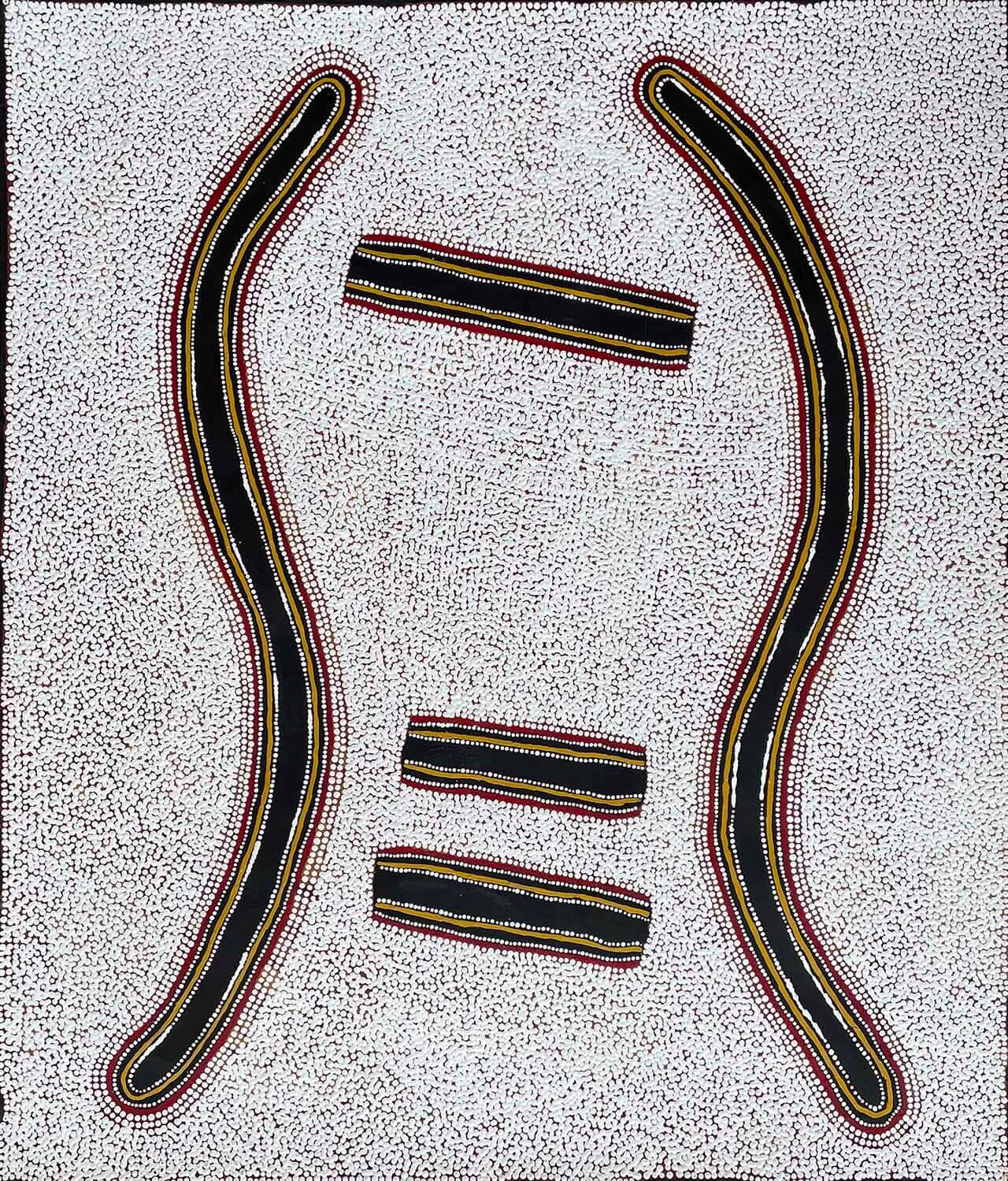
The work of Marcus Kemarre Camphoo is stylistically so different to the other artists in the show. This painting is Untitled - it's very expressionist, very open and loosely painted. Marcus belongs to a younger generation of community artists. He is in his thirties and he is presenting something that is uniquely his own vision of country and his own account of how he experiences culture and country in his own area. They are almost like signs, like stop signs or road signs. You can see these paintings from 20 metres away and know what they are, they're very bold symbols. So Marcus is one of the very distinctive painters from Ali Curung community.
Q&A
Q. Would this have been his style all along or has he tried other things?
A. This is newly emerging community of artists, but as far as I know the artist's style seems to be very consistent, in that it always has the same structural markings. Even if the colours are contrasting, like this red and white, or if they are more subtle and tonal, they all seem to stay in the same structural configuration in his work. They generally maintain just the two colours that make up four quadrants presented on a dark background.
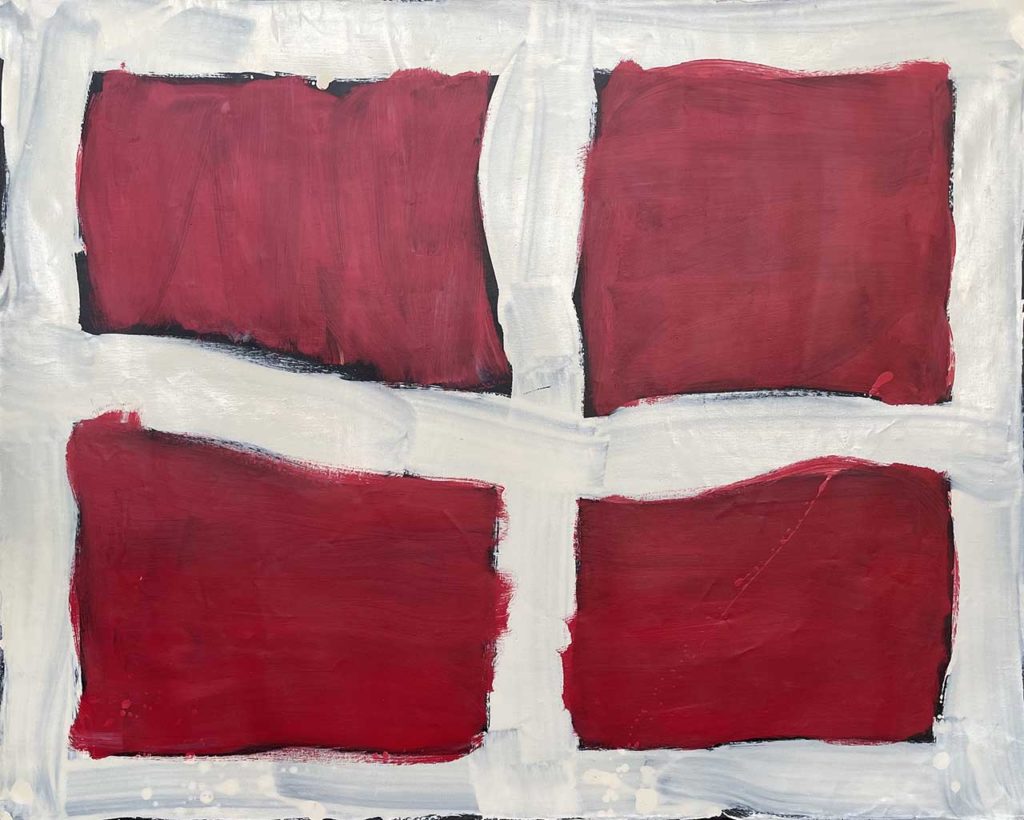
Issues With Water
One of the main concerns for the Ali Curung community is about water rights in their area. They're deeply disturbed by what they're calling unsustainable water rights that have been granted to a nearby cattle station. Naturally they're worried about the impact that this decision will have on their country. They are concerned about lower levels of water in soaks and rock wells on their own country and the potential impace to the native plants on country. At the moment, it troubles them deeply that potentially their country is going to be affected by a lack of water. This might come from climate, but also from the effects of the water rights granted to a neighbouring cattle station.
The Arlpwe Artists exhibition can be seen in Gallery 1 from 8 April - 18 May 2022.
